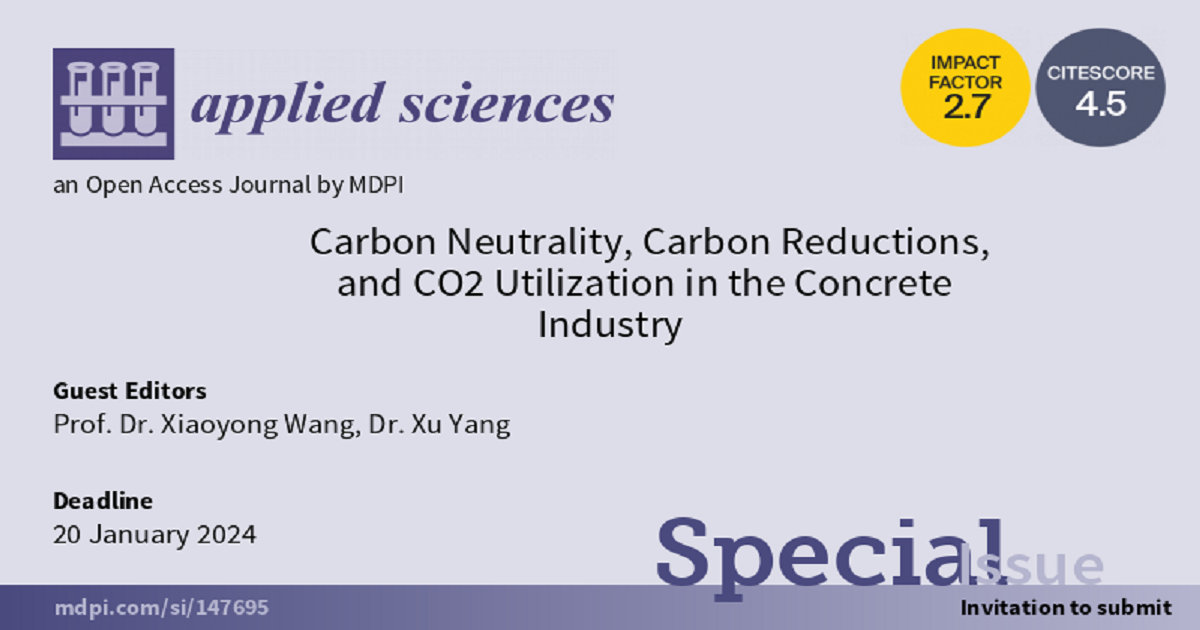Carbon Neutrality, Carbon Reductions, and CO2 Utilization in the Concrete Industry
A special issue of Applied Sciences (ISSN 2076-3417). This special issue belongs to the section "Civil Engineering".
Deadline for manuscript submissions: 20 May 2024 | Viewed by 6435

Special Issue Editors
Interests: cement and concrete; composite structures; numerical modeling
Special Issues, Collections and Topics in MDPI journals
Special Issue Information
Dear Colleagues,
The United Nations Climate Conference have proposed a goal of global carbon neutrality by 2050. In the process of making concrete, a large amount of cement is consumed, and a large amount of carbon dioxide is emitted. In this context, we ask the following questions: How can we achieve carbon neutrality and carbon reductions in the concrete industry? How can we utilize the CO2 emissions? These questions pose challenges which governments and researchers from various countries are very concerned about; solutions are urgently needed. The purpose of this Special Issue is to provide a forum for discussion on carbon neutrality and carbon reductions in the concrete industry. Through this Special Issue, we can explore practical, technical routes for carbon neutralization and carbon reductions in the concrete industry. For example, we can explore the material design of carbon-neutral concrete, the product development of carbon-neutral concrete, and the performance evaluation of low-CO2 concrete. The research topics which will be considered for inclusion in this Special Issue include, but are not limited to, the following: low-carbon concrete; negative-carbon concrete; concrete admixture; concrete carbonation curing; concrete durability; concrete structure life cycle design; volume stability of composite concrete; material design considering climate change; steel slag concrete product development; concrete strength. This Special Issue welcomes both original papers and reviews.
Prof. Dr. Xiaoyong Wang
Dr. Xu Yang
Guest Editors
Manuscript Submission Information
Manuscripts should be submitted online at www.mdpi.com by registering and logging in to this website. Once you are registered, click here to go to the submission form. Manuscripts can be submitted until the deadline. All submissions that pass pre-check are peer-reviewed. Accepted papers will be published continuously in the journal (as soon as accepted) and will be listed together on the special issue website. Research articles, review articles as well as short communications are invited. For planned papers, a title and short abstract (about 100 words) can be sent to the Editorial Office for announcement on this website.
Submitted manuscripts should not have been published previously, nor be under consideration for publication elsewhere (except conference proceedings papers). All manuscripts are thoroughly refereed through a single-blind peer-review process. A guide for authors and other relevant information for submission of manuscripts is available on the Instructions for Authors page. Applied Sciences is an international peer-reviewed open access semimonthly journal published by MDPI.
Please visit the Instructions for Authors page before submitting a manuscript. The Article Processing Charge (APC) for publication in this open access journal is 2400 CHF (Swiss Francs). Submitted papers should be well formatted and use good English. Authors may use MDPI's English editing service prior to publication or during author revisions.
Keywords
- carbon neutrality
- low-CO2 concrete
- CO2 utilization
- negative-CO2 concrete
- mineral admixtures
- durability
- carbonation curing
- service life
- climate change
- steel slag
- material design






